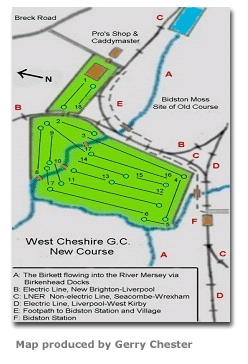|
| |
|
Chapter
10. Padgham’s Year 1936 was the year of the Jarrow Crusade when two-hundred men from the mining and shipbuilding town, not far from my old club Brancepeth Castle, marched to London to draw attention to the devastating unemployment on Tyneside resulting from the Great Depression. In November the BBC began to broadcast television, but it would be twenty years before there was live Open coverage. That year the Open returned to Royal Liverpool, where I had watched Bobby Jones win the title six years earlier. I had moved from Brand Hall to the Wirral and had made a good start in the local Alliance, coming second at Southport’s Hesketh club to Ted Jarman, who had recently taken up his appointment at nearby West Lancashire.  My new club, West Cheshire, just down the road from Hoylake, now
lies partly under the M53 motorway having been wound up half a
century ago, so I guess my course record 63 is safe. I went ‘next
door’ to the Wallasey club for the first Open qualifying round, but
play was abandoned when a violent thunderstorm broke out over the
course and flooded the greens. Henry Cotton’s course record 67,
completed before the storm, was rendered null and void. When play
was re-started the following day, in near perfect conditions, I
almost matched Henry, shooting 68 to lead the field by two shots
from Archie Compston, with a still comparatively unknown
professional from Surbiton – Dai Rees, in third place. I putted
badly in my second qualifying round at Hoylake for a 77, but still
qualified comfortably. My new club, West Cheshire, just down the road from Hoylake, now
lies partly under the M53 motorway having been wound up half a
century ago, so I guess my course record 63 is safe. I went ‘next
door’ to the Wallasey club for the first Open qualifying round, but
play was abandoned when a violent thunderstorm broke out over the
course and flooded the greens. Henry Cotton’s course record 67,
completed before the storm, was rendered null and void. When play
was re-started the following day, in near perfect conditions, I
almost matched Henry, shooting 68 to lead the field by two shots
from Archie Compston, with a still comparatively unknown
professional from Surbiton – Dai Rees, in third place. I putted
badly in my second qualifying round at Hoylake for a 77, but still
qualified comfortably.
Hoylake is a very difficult test, particularly when the wind blows –
as it often does on the exposed corner of the Wirral peninsular
where the Royal Liverpool course lies. Out of bounds threatens on
several holes and you were faced with one of the most daunting
opening drives in golf at the par-4 first, [the third on the revised
course for the 2006 Open] where the out of bounds practise ground is
bordered by one of the low turf banks known as ‘cops’, a feature of
that part of the course. Countless drives have been sent over that
cop and the old-time Open Champion Jamie Anderson once had to reload
five times, after which he was heard to say: “My God, it’s like
playing up a spout”. Bernard Darwin once put so many balls out of
bounds that he “had to give up for want of ammunition”. |

 form
continued and my supporters told me afterwards, “We were praying
that you would find the greenside traps”. They knew that I was a
good bunker player and had more chance of getting close to the hole
with my new ‘blaster’ than with the putter. The renowned Hoylake
greens will yield dividends if you find a good stroke and, in
contrast to my form, last year’s runner-up, Alf Padgham, was holing
almost everything with his individual putting method. Alf had huge
hands in which he held the club with an unbelievably light grip. He
was a ‘streak’ putter who stood very upright, holding his putter
like an extension of his arms, quite a distance from his body and
hitting the ball in his words: “like a short chip”- crisply and
boldly. It was hardly a classic style, but it was very effective and
in the last round he single-putted five of the last six greens.
Bernard Darwin described some of his putts as “indecent”,
particularly a 30-yarder at the 17th, and he recalled that Alf had
only qualified for the first tournament
form
continued and my supporters told me afterwards, “We were praying
that you would find the greenside traps”. They knew that I was a
good bunker player and had more chance of getting close to the hole
with my new ‘blaster’ than with the putter. The renowned Hoylake
greens will yield dividends if you find a good stroke and, in
contrast to my form, last year’s runner-up, Alf Padgham, was holing
almost everything with his individual putting method. Alf had huge
hands in which he held the club with an unbelievably light grip. He
was a ‘streak’ putter who stood very upright, holding his putter
like an extension of his arms, quite a distance from his body and
hitting the ball in his words: “like a short chip”- crisply and
boldly. It was hardly a classic style, but it was very effective and
in the last round he single-putted five of the last six greens.
Bernard Darwin described some of his putts as “indecent”,
particularly a 30-yarder at the 17th, and he recalled that Alf had
only qualified for the first tournament